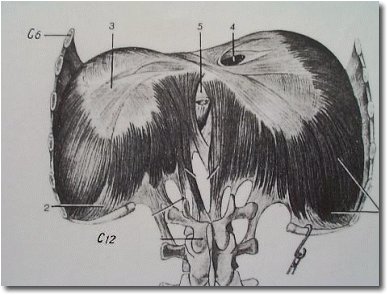|
Fai click qui
per leggere la versione italiana
When/while talking and singing we use three systems:
- breathing system
- laryngic system
- resonator system
This lesson is devoted to an important part of the breathing system: the diaphragm
and its movements.
The diaphragm and its movements
Our body is a wonderful musical instrument. However to let it play we need to know how it works. Let us start from the breathing, so important to sing, talk and … to live.
To breathe well is essential to sing in a right way. Of course a correct breathing is not enough to sing well, but this is the most important thing to know to sing.
The diaphragm, whose etymological meaning is "what is in the
middle", is the core of the breathing system. The diaphragm is a muscle with a large and convex shape witch divides the torax from the abdomen. When we inspire the diaphragm bends like a dome-shaped and in this way it can better hold the note.
What is the diaphragm for?
Besides dividing the two cavities with different functions, the diaphragm is the
chief support of the sound and among its functions there is to hold a note. We could even compare it with a sound-tray.
To feel the "presence" of the diaphragm is one of the most difficult things for a singer, nevertheless is something you cannot give up.
To this purpose, here are some simple excercices:
- Let us laugh, first low and then higher, trying to feel the subsultory
movements of this muscle.
- Now we can try to yawn: in this way the diaphragm reaches its maximum
bending to hold the note. This excercise is useful to realize the position of your
mouth space and your pharynx, which you should always keep open while singing to allow the right sound passage (this will be discussed in the
incoming lessons).
- We can notice how the dyaphragm is involved in the
hiccups or when we sob (this cannot exactly defined an excercise and, indeed, I hope that we can prove
the presence of the diaphragm in this way as less often as possible).
- Who attends singing lessons, can easily feel this muscle during the
excercise of picchettato sound.
This is the back of the
diaphragm:

Insert a comment
©
2000, 2001 Jazzitalia.net - Laura Pigozzi - All rigths reserved
|
© 2000 - 2025 All the material published on Jazzitalia is exclusively owned by the author. Moreover it is protected by International Copyright, so it is forbidden any use of it which isn't authorised by the rights' owner.
|
This page has 4.545 hits
Last Modified Date: 12/11/2003

|
|

